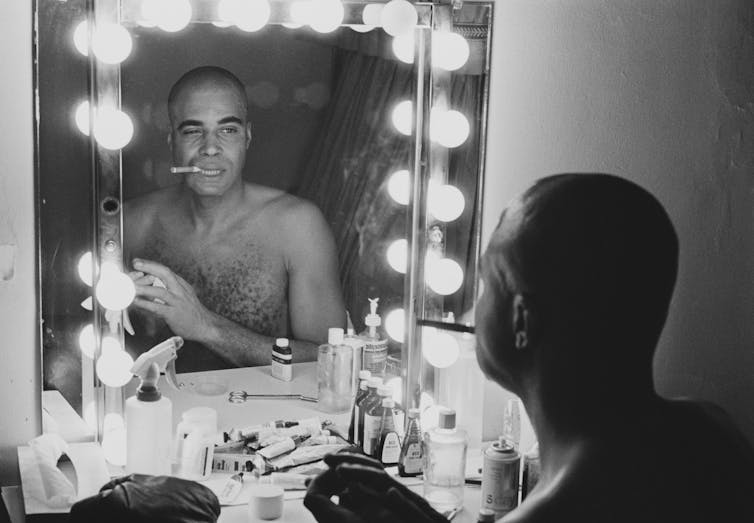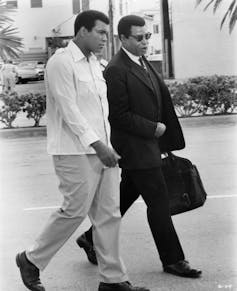Entertainment
What James Earl Jones can teach us about activism and art in times of crisis
James Earl Jones starred in “The Great White Hope,” exploring a boxer’s life reflecting race and cultural struggles, symbolizing a different form of activism.

Dominic Taylor, University of California, Los Angeles
The death of James Earl Jones has forced me to consider the end of an era.
Harry Belafonte, Sidney Poitier and Jones were giants in my industry. They were Black performers whose ascents to stardom occurred in the tumultuous 1960s, when I was an infant. All three were politically active, although each operated in a significantly different way.
In 1967, there were more than 150 riots fueled by racial tensions in U.S. cities. Many Americans worried that the nation would implode over racial conflict, and President Lyndon B. Johnson appointed the Kerner Commission to study the sources of racial turmoil.
At the time, Jones was an actor of growing renown on television and the theatrical stage. He had performed in “Danton’s Death” on Broadway and was featured on NBC’s “Tarzan,” among other projects.
Jones found himself grappling with a question that has roiled many artists, then and now: In troubling times, what is an artist to do?
He didn’t give rousing speeches, as Belafonte did. Nor did he hand-deliver cash to student activists in Mississippi during the Freedom Summer, as Poitier had done.
Instead, Jones decided to work on a play about a boxer, “The Great White Hope,” which had been written by Howard Sackler at Arena Stage, a Washington-based theater company in the growing regional theater movement.
Embodying Black power
While cities were burning all over America, why would an actor hoping to make a difference sign on to play a boxer? If they aren’t willing to put their life on the line, shouldn’t they at least work on a play about the Civil Rights Movement, racism or police brutality?
However, “The Great White Hope” wasn’t a simple, sentimental sports drama. Sackler based the play’s protagonist, Jack Jefferson, on boxer Jack Johnson, who became the first Black heavyweight champion in 1908.
African Americans riotously celebrated Johnson, who had captured the title just 45 years after the Emancipation Proclamation. In the face of virulent Jim Crow racism, Johnson stood as a man who, if given a fair shot, could beat anyone.
In his book “A Beautiful Pageant: African American Theatre, Drama and Performance in the Harlem Renaissance, 1910-1927,” theater historian David Krasner argues that Johnson’s victory was one of the key events that fueled the Harlem Renaissance, the Black intellectual and cultural movement that birthed jazz music, the poetry of Langston Hughes, the writings of Zora Neale Hurston and the sculptures of Augusta Savage.
The confidence Johnson inspired was contagious: If a Black man could handily beat a white man in a boxing ring, there was no reason Black artists and writers couldn’t fashion groundbreaking works, plumbing their lives and their histories – as Hurston did – to become champions of Black culture.
The play is written in three acts, and it follows Jefferson and his fictional white lover, Eleanor Bachman, from 1908 to 1915. After Jefferson wins the title, the government hounds the couple, in part because of their interracial romance. Officials eventually detain them as they enter Ohio under the Mann Act, a law ostensibly enacted to halt prostitution but often used to intimidate interracial couples. The government tells Jefferson that it will drop the charges if he’s willing to throw a fight to an inferior white boxer.
Jones won a Tony Award for his portrayal of a Black man possessed with talent, confidence and strength, whose biggest problem was that he simply refused to stay in his lane. https://www.youtube.com/embed/IVyvwZ_Yh0g?wmode=transparent&start=0 A scene from the 1970 film version of ‘The Great White Hope,’ which also starred James Earl Jones.
A different kind of fighter
Boxer Muhammad Ali was also a big fan of Jones’ performance.
Ali had been stripped of his heavyweight title in 1967 because he was a conscientious objector to the Vietnam War, refusing to enlist after being drafted. When Ali saw “The Great White Hope,” he felt like he was looking in the mirror.
“You just change the time, date and the details and it’s about me!” Life magazine quoted him saying.
It’s strange to think about how historical events can be distilled into emotions like fear, love, jealousy and righteousness. But James Earl Jones was somehow able to hold a Black boxer who loved a white woman in conversation with someone unable to bring himself to fight in Vietnam.
Jones probably knew that a performance on a stage seen by a few thousand people would do little to end the Vietnam War, racial inequality or police brutality.
But I think Jones was looking to change the culture. He was trying to change the country’s understanding of what it means to fight – and what a freedom fighter is.
Is a fighter someone who knocks out their opponent? Or someone who follows their heart? Is a fighter someone who takes up arms at the behest of their government? Or is a fighter someone who’s willing to risk their livelihood for their values?
Sometimes, activism can be as simple as making art to the best of your abilities – or, as W.E.B. Du Bois wrote, “to use beauty to set the world right.”
Dominic Taylor, Acting Chair of Theater, School of Theater, Film and Television, University of California, Los Angeles
This article is republished from The Conversation under a Creative Commons license. Read the original article.
Join us at Looking for an entertainment experience that transcends the ordinary? Look no further than STM Daily News Blog’s vibrant Entertainment section. Immerse yourself in the captivating world of indie films, streaming and podcasts, movie reviews, music, expos, venues, and theme and amusement parks. Discover hidden cinematic gems, binge-worthy series and addictive podcasts, gain insights into the latest releases with our movie reviews, explore the latest trends in music, dive into the vibrant atmosphere of expos, and embark on thrilling adventures in breathtaking venues and theme parks. Join us at STM Entertainment and let your entertainment journey begin! https://stmdailynews.com/category/entertainment/
and let your entertainment journey begin!
Discover more from Daily News
Subscribe to get the latest posts sent to your email.
actors & performers
Harkins Theatres Announces Rob Reiner Tribute Screening on December 17
Rob Reiner Tribute: Harkins Theatres will host a special $5 screening of The American President on December 17 to honor filmmaker Rob Reiner, with all proceeds benefiting the Human Rights Campaign.
Last Updated on December 17, 2025 by Daily News Staff
Harkins Theatres Announces Rob Reiner Tribute Screening of The American President
Harkins Theatres has announced a special one-day tribute screening honoring acclaimed filmmaker Rob Reiner, celebrating his life’s work and cinematic legacy.
On December 17, select Harkins locations will screen Reiner’s 1995 political romance The American President, with all proceeds benefiting the Human Rights Campaign. Tickets are priced at $5, making the event both an accessible film experience and a charitable fundraiser.
The tribute was announced via Harkins’ official, verified social media accounts and is positioned as a legacy celebration, not a memorial.
🎥 Why The American President?
Released in 1995 and written by Aaron Sorkin, The American President stars Michael Douglas and Annette Bening and remains one of Rob Reiner’s most politically resonant films. The movie blends romance, idealism, and civic responsibility — themes that have consistently appeared throughout Reiner’s career.
The film later served as a creative blueprint for The West Wing, cementing its place in modern political storytelling.
📌 Event Details at a Glance
Event: Rob Reiner Tribute Screening
Film: The American President (1995)
Date: December 17
Price: $5
Where: Select Harkins Theatres
Beneficiary: Human Rights Campaign
Host: Harkins Theatres
🔗 Official Event Page:
https://www.harkins.com/movies/the-american-president-a-rob-reiner-tribute
![]()
🎞️ Rob Reiner’s Lasting Impact
Rob Reiner’s career spans more than five decades, including landmark films such as:
This Is Spinal Tap
Stand By Me
The Princess Bride
When Harry Met Sally…
Misery
A Few Good Men
His work is often praised for balancing entertainment, empathy, and social conscience, making tribute events like this especially meaningful to longtime audiences.
Hollywood vs. Reality: How LA’s Wilshire Subway Was Really Built
https://stmdailynews.com/wilshire-subway-tunneling-hollywood-vs-reality/
Discover more from Daily News
Subscribe to get the latest posts sent to your email.
actors & performers
Hollywood Legend Rob Reiner and Wife Found Dead; Son in Custody
Renowned filmmaker Rob Reiner and his wife, Michele Singer Reiner, were found dead in their Los Angeles home in a reported homicide. Police have arrested their son in connection with the case, and tributes are pouring in.
Last Updated on December 16, 2025 by Daily News Staff
Director Rob Reiner participates in a discussion following a screening of the film LBJ at the LBJ Presidential Library in Austin, Texas on Saturday October 22, 2016
On Saturday evening October 22, 2016, the LBJ Presidential Library held a sneak peek of Rob Reiner’s new filmÊLBJ, starring Woody Harrelson as the 36th president. The film, which premiered at the Toronto International Film Festival in September, chronicles the life and times of Lyndon Johnson who would inherit the presidency at one of the most fraught moments in American history.
Following the screening, director Rob Reiner, actor Woody Harrelson, and writer Joey Hartstone joined LBJ Library Director Mark Updegrove on stage for a conversation about the film.
LBJ Library photo by Jay Godwin
10/22/2016
Hollywood Legend Rob Reiner and Wife Found Dead; Son in Custody
December 15, 2025
Renowned filmmaker and actor Rob Reiner, 78, and his wife Michele Singer Reiner, 68, were found dead in their Brentwood, Los Angeles home on Sunday, authorities say. Emergency responders were called to the residence Sunday afternoon, where both were discovered with fatal wounds consistent with a stabbing. Police are treating the case as a double homicide.
Los Angeles police arrested the couple’s 32-year-old son, Nick Reiner, in connection with the deaths. He is being held in custody as investigators continue to piece together the circumstances surrounding the incident.
2016 SAMHSA Voice Awards
Reiner was one of Hollywood’s most influential figures, known for his work as a director, producer and actor. His career spanned decades, from early television fame to directing beloved films that shaped American cinema.
Friends, colleagues and public figures have begun sharing tributes and reactions to the news as the investigation is ongoing.
More details will be updated as they become available.
The Inspiring Legacy of Raymond E. Fowler: A Journey into the UnknownLink: https://stmdailynews.com/the-inspiring-legacy-of-raymond-e-fowler-a-journey-into-the-unknown/
Discover more from Daily News
Subscribe to get the latest posts sent to your email.
Entertainment
Hollywood vs. Reality: How LA’s Wilshire Subway Was Really Built
Wilshire Subway: Did LA blast subway tunnels under Wilshire Boulevard? Hollywood says yes — engineers say no. Here’s how Metro safely tunneled beneath Miracle Mile.
When the 1997 disaster film Volcano depicted lava erupting along Wilshire Boulevard and referenced blasting during Red Line subway construction, it delivered gripping cinema — but not accurate engineering.
In reality, Los Angeles Metro did not rely on large-scale blasting to construct subway tunnels beneath Wilshire Boulevard and the Miracle Mile. Instead, engineers used tunnel boring machines (TBMs) specifically to avoid the very risks Hollywood dramatized.
Why Blasting Was Avoided
The Wilshire Corridor sits atop historic oil fields, making methane gas pockets a known and serious concern. A deadly methane explosion near Fairfax Avenue in 1985 led to heightened scrutiny of underground construction in the area. Blasting in such conditions could have caused unpredictable gas releases, ground instability, or damage to surface structures.
As a result, Metro engineers chose pressurized, closed-face tunnel boring machines, which allow for:
Controlled excavation in dense urban environments
Continuous ground support to prevent settlement
Integrated gas detection and ventilation systems
These machines grind slowly through soil and rock while installing precast concrete tunnel linings, creating a sealed, gas-resistant structure as they advance. ![]()
The Real Engineering Feat
Although Volcano took creative liberties for dramatic effect, the true story of tunneling under Wilshire is no less impressive. Advances in TBM technology and methane mitigation ultimately allowed the Metro D Line (formerly the Red Line/Purple Line) to safely pass through one of Los Angeles’ most geologically complex corridors — without explosions, collapsing streets, or cinematic chaos.
Bottom Line
Volcano remains a memorable piece of 1990s disaster cinema, but its portrayal of subway construction is fiction. The real achievement lies in decades of careful planning, modern tunneling technology, and engineering solutions that quietly reshaped Los Angeles beneath its busiest boulevard.
Related Links:
- LA Metro – D Line (Purple Line) Extension Project
- Engineering News-Record: Tunneling Through Gas and Tar in LA
- Los Angeles Times Archive: Methane Risk and Subway Construction
Dreambreaker: A Pickleball Story — A Closer Look at the Documentary and Its Uncredited VoiceLink: https://stmdailynews.com/dreambreaker-a-pickleball-story-a-closer-look-at-the-documentary-and-its-uncredited-voice/
Discover more from Daily News
Subscribe to get the latest posts sent to your email.

